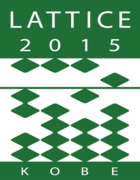Speaker
Dr
Christopher Pinke
(Goethe University Frankfurt)
Description
The clarification of the order of the thermal transition in the chiral limit of QCD with two dynamical flavours of quarks is a long-standing issue. Still, it is not definitely known if the transition is of first or second order. Which of the two scenarios is realized has important implications for the physical QCD phase diagram, and in particular it is important regarding the existence of a critical endpoint at finite densities. Settling this issue by simulating at successively decreased pion mass was not conclusive yet, primarily because of the increasing demands of the simulations as the pion mass is lowered.
Recently, an alternative approach was proposed, which relies on the nontrivial phase structure of QCD at purely imaginary chemical potential $\mu_I$ induced by the Roberge-Weiss symmetry. At critical values of $\mu_I$, the endpoint of the Roberge-Weiss transition is mass-dependent and changes from a triple point at low and high masses to a second order endpoint for intermediate masses. These regions are separated by tricritical points. Leaving the critical $\mu_I$-values, it is known that lines of second order transitions depart from the tricritical points, separating regions of first order transitions from crossover regions. Furthermore, at $\mu_I$ the sign problem is absent and standard simulation algorithms can be applied.
Hence, determining the second order line for lower quark masses is possible. The line is governed by tricritical scaling laws, which then allow an extrapolation to the chiral limit. In this way one can clarify the order of the chiral limit at zero chemical potential.
Using staggered fermions on $N_t=4$ lattices, it was indeed found that the transition is of first order in the chiral limit. These findings have to be contrasted with other fermion discretizations. In this talk, we report on the status of our simulations with Wilson fermions following the same approach.
Author
Dr
Christopher Pinke
(Goethe University Frankfurt)
Co-author
Prof.
Owe Philipsen
(Goethe University Frankfurt)

